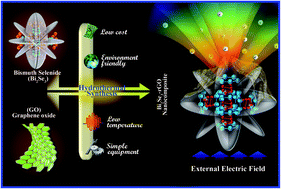rGO-Wrapped flowerlike Bi2Se3 nanocomposite: synthesis, experimental and simulation-based investigation on cold cathode applications†
Abstract
Bi2Se3 nanoflowers (NFs) and reduced graphene oxide (rGO) nanocomposite (BG) have been synthesized by a cost-effective, ecofriendly and easy hydrothermal route for the first time. Thorough characterizations confirm the phase, chemical composition and morphology of the samples. Room temperature transport measurement showed that the composite samples exhibit enhanced electrical conductivity compared to the pure Bi2Se3 nanoflowers (NFs). The possibility of using this composite in applications such as low macroscopic field emitters for cold cathode application has been investigated. For this, theoretical simulations are performed for pure and composite samples with graphene wrapping of different degrees and to evaluate the relation between the degree of rGO wrapping and the enhancement of FE properties, and the same was verified experimentally. It is observed that the enhancement factor for cold cathode emission of Bi2Se3–rGO (BG) composite is almost 5 times higher than that of pristine GO, 2.6 times that of rGO and nearly 1.5 times higher than that of pure Bi2Se3 NFs. The enhancement of the cold emission properties is attributed to suitable wrapping of rGO sheets over Bi2Se3 NFs. This produces more curvature at the nanoflakes edges and the electron affinities between the materials are favorable for the enhancement of cold cathode emission. The sample exhibiting the best FE properties also showed photoresponse properties under visible light excitation.


 Please wait while we load your content...
Please wait while we load your content...